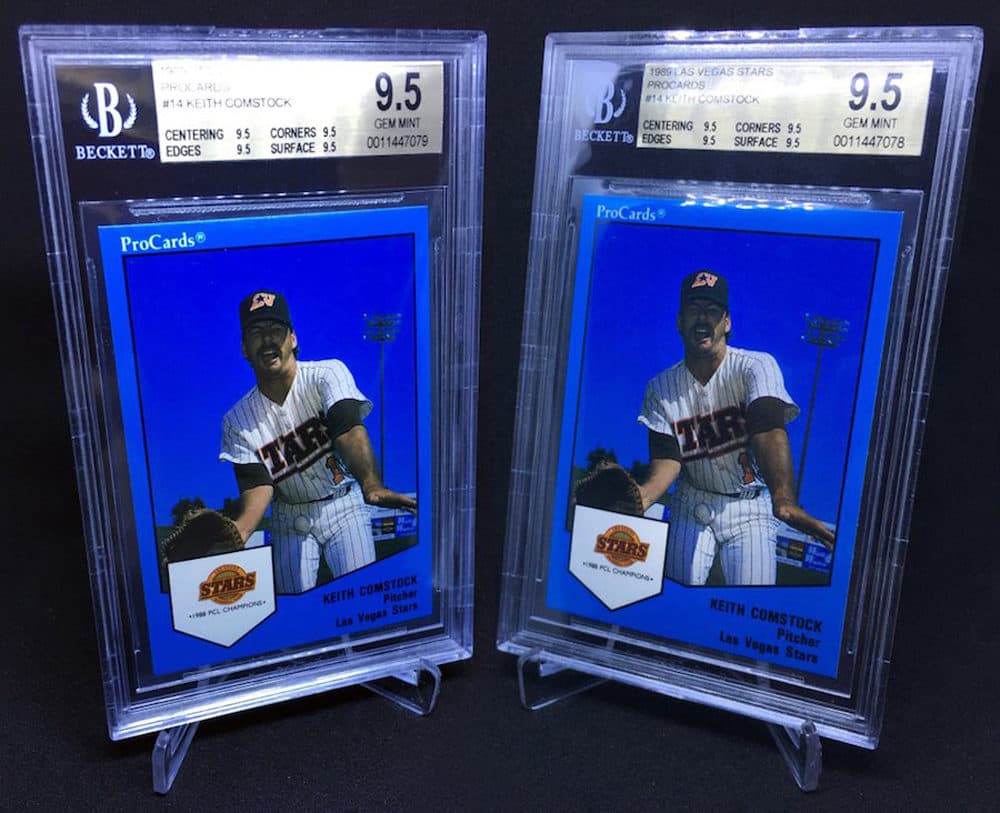Advertisement
The Baseball Card That Made Keith Comstock A Legend
Resume
Keith Comstock played professional baseball for 17 years.
"Nine years in the minor leagues, I played two years over in Japan, and then I played six years in the big leagues — parts of six years," he says.
When he runs into baseball fans out in the world, some are curious about his time in Japan.
"But, mostly, they want to talk about that baseball card," he says. "That card goes a long way in conversations."
"So 17 years — that's what's risen to the top?" I ask.
"That's pretty much, yeah," Comstock says with a laugh.
So picture this: Comstock's got his uniform on, with his hands stretched out in front of him, and he’s got this horribly pained look on his face. His eyes are squeezed shut. His mouth is open, like he’s letting out a scream.
But what makes this card truly stand out — the reason fans continue to bring it up — is the location of the baseball in the photo.
And the story of how Comstock made this happen, how he got this image on a real baseball card, may be even more bizarre than the photo itself.
"Yeah, there was a lot of thinking on your feet," Comstock says.
The Minor League Grind
Growing up, Keith Comstock kept his baseball cards in two shoe boxes. One was for the special cards: the star players you wanted to hold onto.
The other was for cards destined for service in his bicycle spokes.
"The cards only lasted like two or three days in a bicycle, so I'd always have to keep replenishing those cards," Comstock says. "So if I got a Reggie Jackson card — yeah, I saved Reggie. But if I got — and I love Dick Green; Dick Green was a hard-nosed baseball player — but if I got Dick Green from the Oakland A’s, he went into my bicycle spokes and became my motorcycle."
"Did you dream of having your own card?" I ask.
"I don’t think there was a dream, to be honest with you," Comstock says. "Somewhere along the line, it became more of a vision than it did a dream."
Keith Comstock was a standout left-handed pitcher at Cañada College in California, where, according to the school, he once struck out 22 batters in a single game. And when Comstock was 20 years old, the California Angels selected him in the fifth round of the 1976 MLB draft.
Comstock ended up in Iowa, playing for the Single-A Quad Cities Angels. That’s where he got his first card as a professional baseball player.
"It is not a good picture," Comstock says with a laugh. "It's black and white. It's, like, point blank. My eyes are all squinty, and I just kind of [have] this look on my face like I just ate a lemon or something."
"But I bet when you got, it was still pretty amazing to see," I say.
"Oh, yeah," he says. "And the thing was, I didn't know if I was going to get another one or not."
But Comstock would get plenty more minor league baseball cards — more than he’d want, in fact.
And there’s something important to know about minor league baseball cards. Unlike major league cards, which feature action shots from actual games, minor league cards, at least back then in the late '70s, used posed photos.
So as he toiled away in the minors for the next five, six, seven years, Comstock became very familiar with the limited pose options.
"You're lifting your leg and you're holding your balance point," Comstock remembers. "The other one is when you're finishing your follow through, and the ball's still in your hand. It looks like you're about ready to release it. There's other ones that you would kind of just sit there in a stretch position, or in a windup position before you even started.
"Those got boring. And, unfortunately, the reason why I got tired of doing the same thing was because I was in the minor leagues for so long."
But in 1987, 11 years after he was drafted, Comstock finally stayed in the Majors long enough with the San Diego Padres to earn his first big league card.
"And so when you get that first card in the mail, man, there was just nothing like it — at least not for me," Comstock says. "I played with Ken Griffey Jr., and I'm sure his first baseball card was a totally different experience. Because it was a year after high school. Mine was, you know, I'm almost in my 30s for crying out loud, so it was justification of me sticking through it."
(Keith would actually have been 32 when his Padres card came out in 1988.)
"But that first card I got — I remember I was still at my mom's house, and my dad had passed away years earlier. And my mom and I saw it, and I gave it to my mom right away. Now, she might've put it in my bicycle spoke for all I know," Comstock jokes.
'I'm Gonna Take It To The Nuts'
But after finally getting a real taste of the big leagues, Keith Comstock got sent back down to the minors. He ended up on the Triple-A Las Vegas Stars for the 1988 season. He was now 32 years old, playing for a team stacked with young prospects.
And then, one day, the photographer from ProCards showed up.
"It was a Sunday morning," Comstock recalls. "He was running late, and he wanted to get things done. It was kind of a big setup."
The photographer had a checklist with all the players on the roster. And he was having them go through the usual poses.
For Keith Comstock — who’d been in the minor leagues for so long, who’d finally gotten a real major league baseball card — this was tough to take. So, before it was his turn, Comstock basically snapped.
"I’m like, 'I’m tired. I want to do something different,' " Comstock recalls.
Now, the creative process can be mysterious, and Comstock's not sure where exactly this particular stroke of inspiration came from. But he decided that he wanted — no, needed — his baseball card to feature him taking a baseball ... to the crotch.
"I just said, 'I'm gonna take it to the nuts,' " Comstock says. "And then, you know, to make a face like, [if] that ball is hitting you in that area and how much it would hurt."
After some trial and error, Comstock figured out he could get the ball to stick to his pants (for at least a few seconds) with the help of some super glue.
Comstock presented the idea to the photographer.
"He’s like, 'Hey, I don’t know about this. I can’t do this. I’m under strict orders about just taking set shots. I’ve got pitcher shots here. Balance points,' " Comstock recalls. "He’s telling me all these kinds of poses that he wants me to do. And I said, 'Been there, done that.' And he goes, 'No, I can’t take it, man. I’m sorry.' So he drew his line in the sand, and he just didn’t think I was going to come across."
Comstock and the photographer had reached a stalemate.
And that’s when one of Comstock's fellow relievers had an idea. It would require the support of the younger prospects up in the clubhouse who hadn’t yet come down to take their photos.
"He said, 'Hey, just go up there and tell these guys not to come down until you've taken this picture. Tell them what you want to do,' " Comstock recalls.
In other words, use the prospects as leverage to get the photographer to budge. Comstock was on board to give it a shot.
So what did Comstock tell his teammates?
"It wasn't a big, you know, like that big Mel Gibson 'Braveheart' speech, anything that was inspirational by any means," Comstock says. "It wasn't like I thought up [a] big thing where I had people in tears, or wanting to fight for me, and — 'Yeah, yeah!' — screaming — "Yeah, yeah!' "
"No, it was more or less guys reading the paper saying, 'Whatever, man. Yeah, sure, go ahead, go. I’m all for it. Go ahead.' "
"I'm gonna take it to the nuts."
Keith Comstock
With that vigorous backing from his teammates, Keith Comstock returned to the photographer.
"And so I just walked over to him, saying, 'Hey, they're not going to come down,' " Comstock says. " 'They're young. I'm old. I want this picture done. They know how much I want it done. So we've got to get this done.' He goes, 'All right, get over there.' So, boom. We got it done."
That next season, with Comstock still playing for the Triple-A Las Vegas Stars, the card showed up at the clubhouse.
"Oh, son of a gun. There it is," Comstock says. "And I was so proud of myself. I mean, you could have told me that I was a Cy Young Award winner, and I don't think I would've felt as much pride as I did [with] that baseball card."
"I mean, yeah, there have been a lot of Cy Young winners," I say.
"Yeah, there's only one baseball card like that," Comstock says.
Except not any more: In the 30 years since Comstock's famous card showed up in that 1989 ProCards set, at least one other player has imitated his pose. And with that kind of legacy, Keith Comstock shouldn’t have to worry about that card ending up in anyone’s bicycle spokes.
We first learned about the saga of Keith Comstock’s baseball card in his ESPN piece with Robert Sanchez. Comstock is collaborating on a forthcoming novel based on his career called “The Conman.”
This segment aired on October 12, 2019.
